Hibernation &
Den Research: Q&A with a Black Bear Biologist
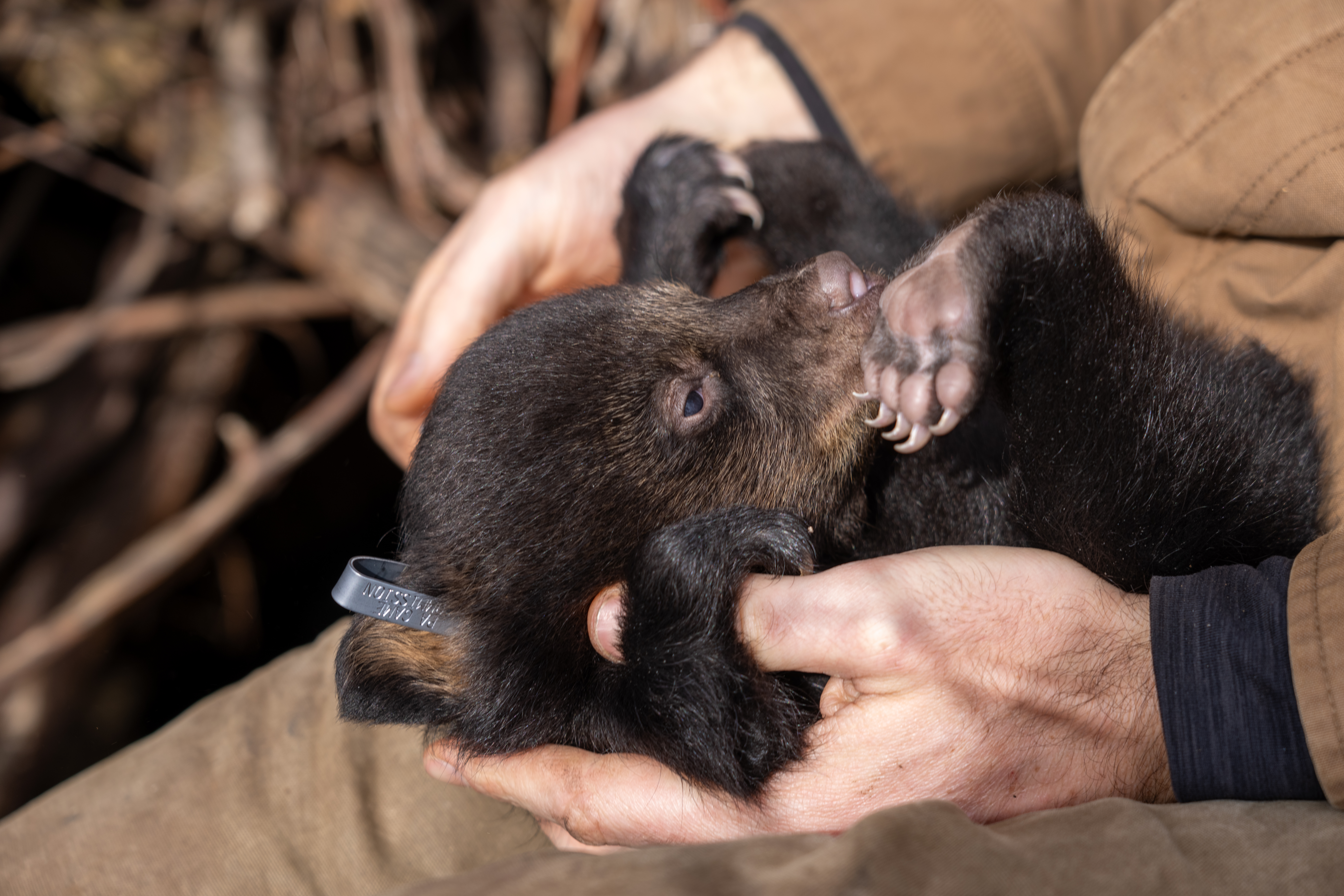
Do bears really snooze through the entire winter season? How can they survive for months without eating? And what can we learn by collecting data while they’re denning?
Emily Carrollo, the Pennsylvania Game Commission’s black bear biologist, weighs in on all things bear dens and hibernation.
What types of dens do black bears choose in Pennsylvania?
EC: Black bears most commonly choose to den on top of the ground in what we call “ground nests” in Pennsylvania. Over 50 percent of dens here are what look like giant bird nests on the ground and are often in dense cover like mountain laurel thickets. However, bears will den in brush piles/treetops of blown or cut down large trees, rock cavities, dug-out holes in the ground or sides of hills, hollowed out trees (we call these “smokestack dens”), and even under or in human structures like porches or road culverts.
How do you find where bears are denning?
EC: We locate our research bears using the research collars they wear that send us GPS locations of where the bear is. We also use radio telemetry that essentially uses radio signals and antennas to communicate between the collar and a handheld receiver on our end, and we use signal strength to help guide us in the right direction and right to where the bear is denned exactly. The GPS locations sent to us often aren’t exact, and bear dens can be difficult to find even when you’re right on top of them. The GPS locations get us to the immediate area where we need to look for the bear, and the radiotelemetry system helps us find exactly where the den is.
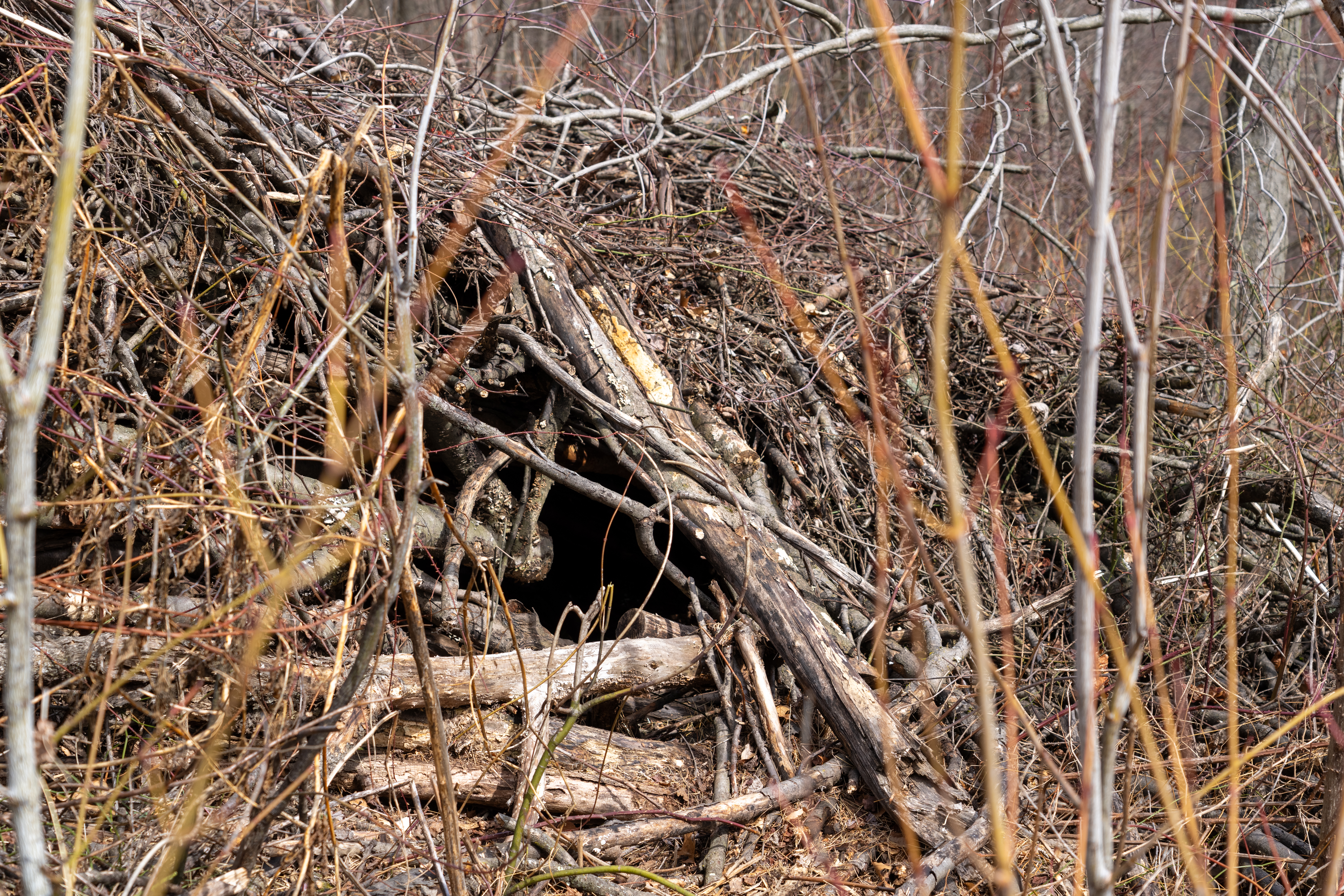
How many bears do you usually find in a den?
EC: This depends on what kind of den we’re visiting. We’ll only find one bear if we’re visiting an adult male’s den. But if we’re visiting a den of an adult female bear that has yearlings or cubs, there could be several bears in a den. We’ve visited many dens where a mother has several yearlings with her, and they’re crammed into a space you wouldn’t expect to see that many bears.
Why do bears hibernate?
EC: Bears hibernate to get through a low food period. Essentially, when food gets to low enough levels that bears are burning more calories to find food than they’re consuming, bears take a long nap and live off fat stores they’ve built up over the summer and fall months. In some places like Florida, it’s not uncommon to see adult bears who don’t have dependent young winter out and about because food is often available throughout the year due to warmer and more tropical conditions in the southern range for black bears. However, if for some reason food resources are scarce in those areas, bears will hibernate just like their northern cousins.
How long do bears hibernate?
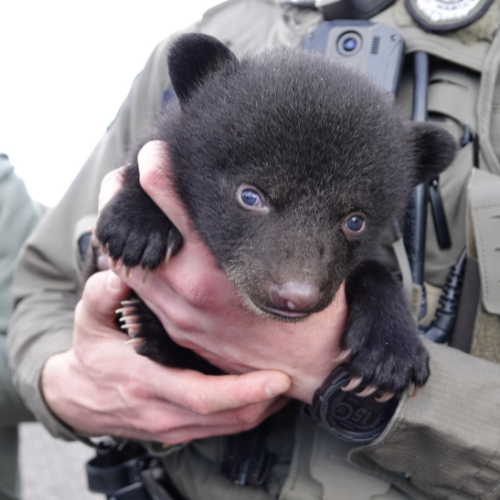 EC: This depends on several factors, like where within the black bear range, age of the bear, sex of the bear, and the reproductive status of the bear. In Alaska and Canada, black bears can hibernate upwards of 6 months, while bears in the southern portion of the black bear range may not den at all if they don’t have dependent young with them and there’s still plenty of food on the landscape (i.e., adult male bears in Florida). In Pennsylvania, it’s not uncommon for pregnant females to go through the longest denning periods that typically start in mid-November and end in early April. Adult males usually have the shortest denning period, which may not start until late December and end as early as mid- to late March. Young bears who are on their own for their first winter tend to den later than adult females but earlier than adult males. Pregnant adult females tend to den earlier than adult females who have young with them from the previous winter. Long story short: black bears hibernate anywhere from 3-5 months in Pennsylvania, depending on the several factors above.
EC: This depends on several factors, like where within the black bear range, age of the bear, sex of the bear, and the reproductive status of the bear. In Alaska and Canada, black bears can hibernate upwards of 6 months, while bears in the southern portion of the black bear range may not den at all if they don’t have dependent young with them and there’s still plenty of food on the landscape (i.e., adult male bears in Florida). In Pennsylvania, it’s not uncommon for pregnant females to go through the longest denning periods that typically start in mid-November and end in early April. Adult males usually have the shortest denning period, which may not start until late December and end as early as mid- to late March. Young bears who are on their own for their first winter tend to den later than adult females but earlier than adult males. Pregnant adult females tend to den earlier than adult females who have young with them from the previous winter. Long story short: black bears hibernate anywhere from 3-5 months in Pennsylvania, depending on the several factors above.
What does the hibernation process look like? How is this different from other species?
EC: Black bears experience a decrease in metabolic rate, heart rate, and respiration rate during hibernation. All of this helps keep energy use to a minimum and ensure bears efficiently use fat stores to get them through this low food period/winter. This is like other species that experience decreased metabolic rates. But bears are the largest species to go through a metabolic change during hibernation, and because of their size, they must do it differently than the other species. For example, animals like chipmunks or groundhogs go through periods of torpor, where metabolic rates are so low, it’s almost as if they’re dead. However, this process for smaller mammals is cyclical, and after a period of this deep torpor, the small mammals will “wake” and warm their bodies up to their normal temperatures for another short period during which they also consume food they’ve stashed away for the winter. This cycle of deep torpor and “awake” periods continues throughout the low food months until small mammals can actively begin to forage for food on the landscape again.
The decrease in metabolic rate for bears is not nearly as extreme as the decreases small mammals experience, and bears are very aware of their surroundings during the entire period of hibernation. They can react to possible threats and will leave dens if they feel they need to. Bears also don’t eat, drink, urinate, or defecate, which is different from small mammals. Both strategies are beneficial for the species that use them and work for their biological needs.
Why does the Game Commission visit bear dens? What type of data do you gather?
EC: At bear dens, we tag cubs or yearlings that weren’t tagged the year before, collect biological samples like blood and hair from both collared bears and young when applicable, download collar data like GPS or activity information, and make sure the collars we are using still fit appropriately and are in proper working condition.
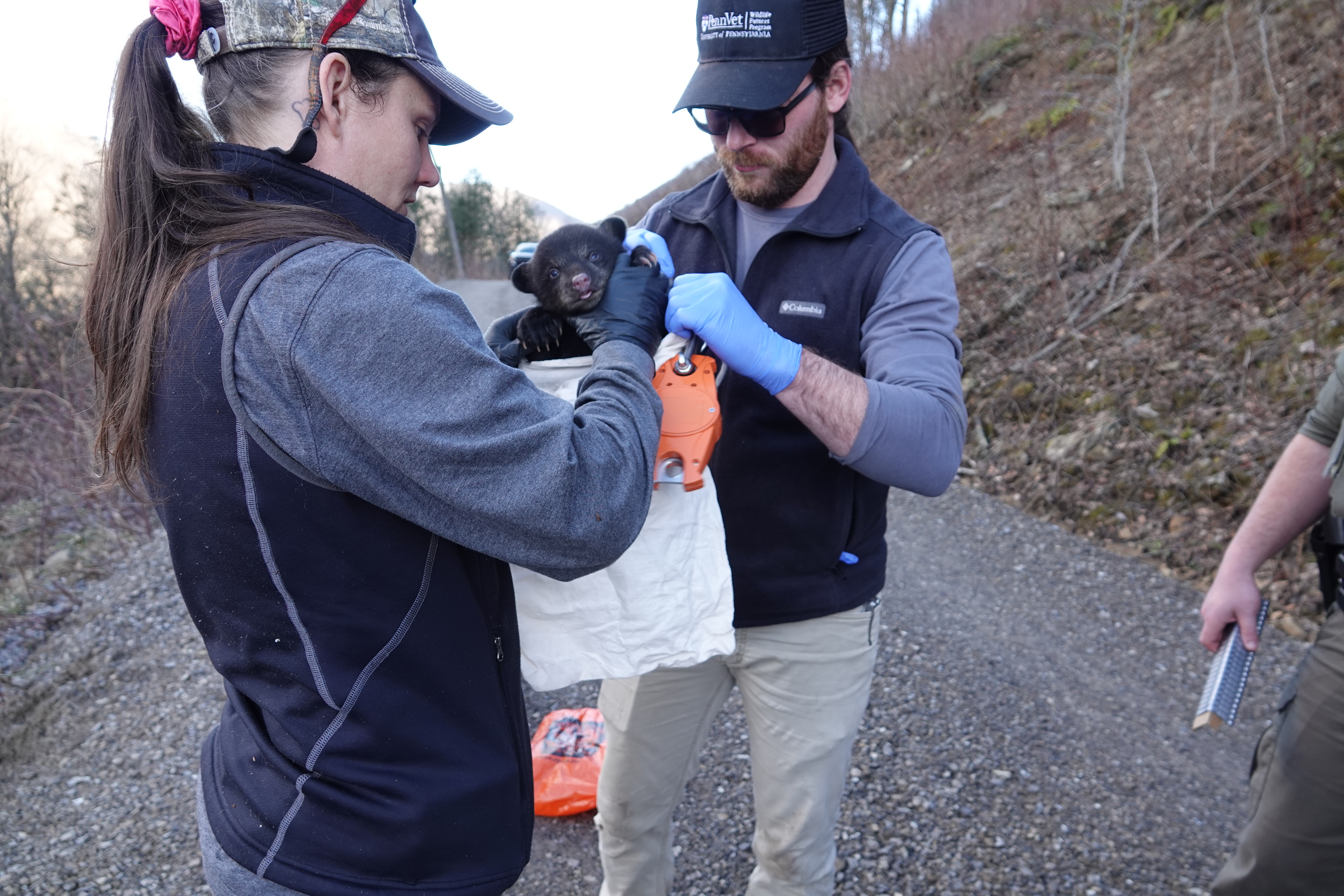
Most of the biological samples are collected in our biobank, which is long-term storage of biological samples for disease monitoring and projects. Sometimes samples are collected for more specific projects and analysis we have going on and are used immediately.
The GPS data can be used for all sorts of projects, including studying survival, resource selection, diet analysis, population monitoring, and reproduction. Currently, most of the animals we have “on air” are used for orphan cub placement and reproduction monitoring (all the bears with GPS collars right now are adult females). But moving forward into next year, we’ll be using GPS data to understand survival of both males and females across a large age range and how things like landscape, hunter pressure and season dynamics, age, sex, and other variables affect the likelihood of survival from year to year.
What is the Game Commission going to learn from its new black bear survival project?
EC: We’ll be looking at annual survival for adult and yearling bears as well as how sex, age, landscape, and other variables affect survival of black bears in Pennsylvania from year to year. This information will be put into population models we’re building that require auxiliary data like survival information to estimate things like abundance and harvest rates. These survival rates will help build more accurate population and harvest estimates that are estimated via these models for the state and WMU level. The plan is to improve how we currently estimate the bear population and make the best management decisions regarding the resource moving forward. This project will be expansive and cover the entire state, which is the first of its kind in Pennsylvania. We will be GPS collaring hundreds of bears over 5 years, which will provide a ton of data for this project and will be useful for future research projects as well.
How do you make sure the bears don’t run away or get aggressive when you’re doing this work?
EC: All bears other than cubs that are handled during the den season are immobilized using drug combinations that temporarily put bears to sleep while we complete the work we need to do. We often use dart pistols to inject the drugs into the bear from a small distance away and disturb dens as little as possible. Additionally, we always approach dens before we’ve darted a bear with only a few highly trained individuals so we can be as quiet as possible.
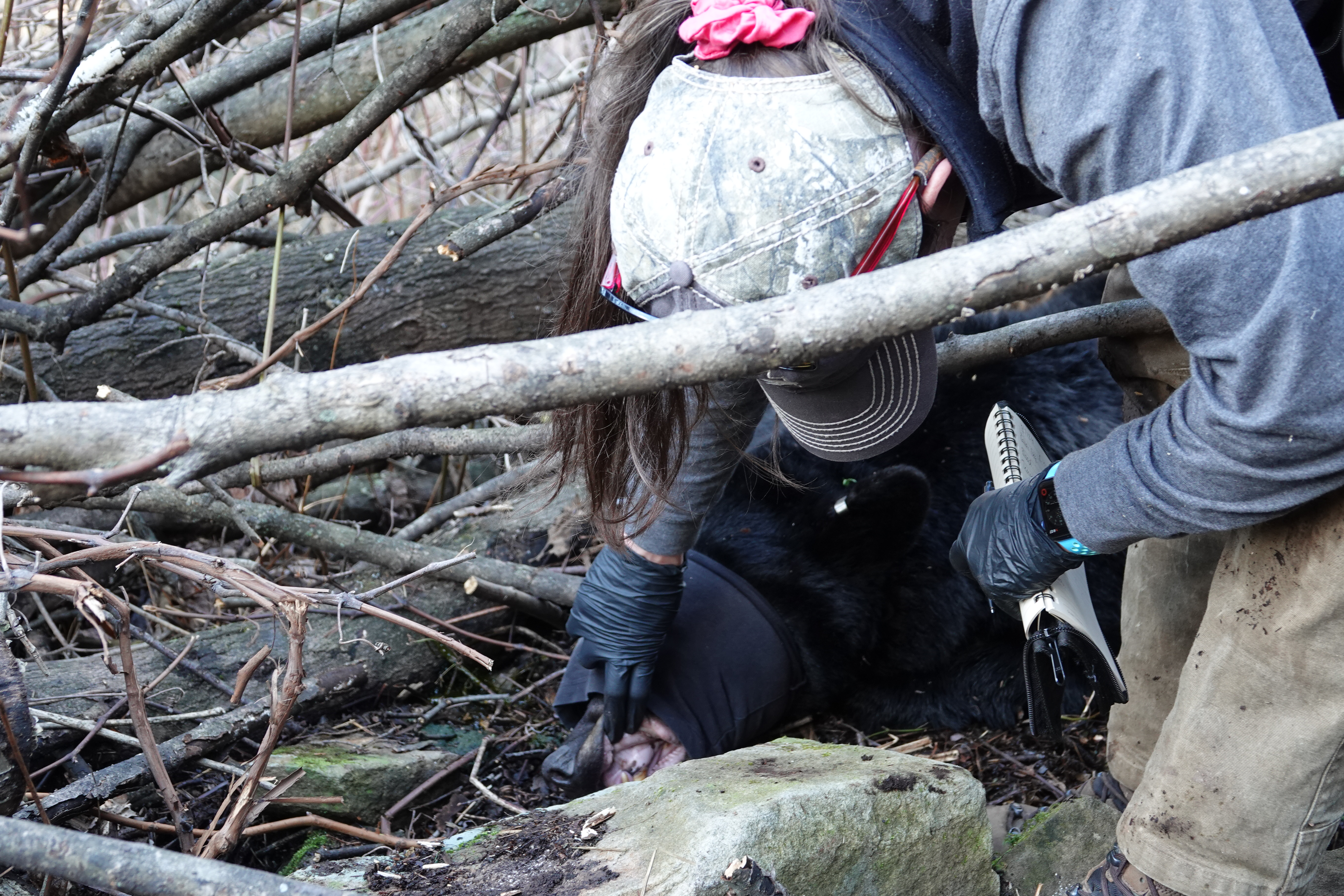
What happens if a cub gets separated from its mother?
EC: While mother black bears are fantastic moms, occasionally cubs are orphaned often due to human disturbance. Fortunately, females that have cubs are also very receptive to taking in other cubs in the first several months they have them. When cubs are abandoned during the winter months, the PGC will try to place orphans with females that have GPS collars on and are specifically used for orphan cub reintroductions. When the females and cubs leave the den, we still have a few weeks to get orphan cubs with the family groups. But once the trees have leaves, it becomes too difficult to get orphan cubs with the cubs of the family. Often, orphan cubs are brought to a specially licensed rehab facility when we no longer can introduce them to a family group, and they’re released into the wild in the beginning of the fall when hard mast is abundant on the landscape. Once cubs are around 7 months old, they can be independent and survive on their own. Depending on the circumstances surrounding an orphan cub, we tend to leave them in the wild when they reach that seven-month mark, so they have less of a possibility of becoming habituated by people.
What are some other interesting facts the average Pennsylvanian might not know about black bears?
EC: Bears don’t eat, drink, urinate, or defecate during hibernation. Bears actually form a fecal plug, often from very fibrous material (like mountain laurel), and they expel this plug shortly before they leave their den for good.
Bears rarely reuse dens. If a den is reused, it’s usually by another bear.
Bears have no collar bones, which allows them to squeeze into small spaces.
Adult bears shed their paw pads each den season, and new paw pads form each year.
Adult females are pregnant and give birth during the hibernation period.
All black bears in Pennsylvania are born between mid-January and early February.

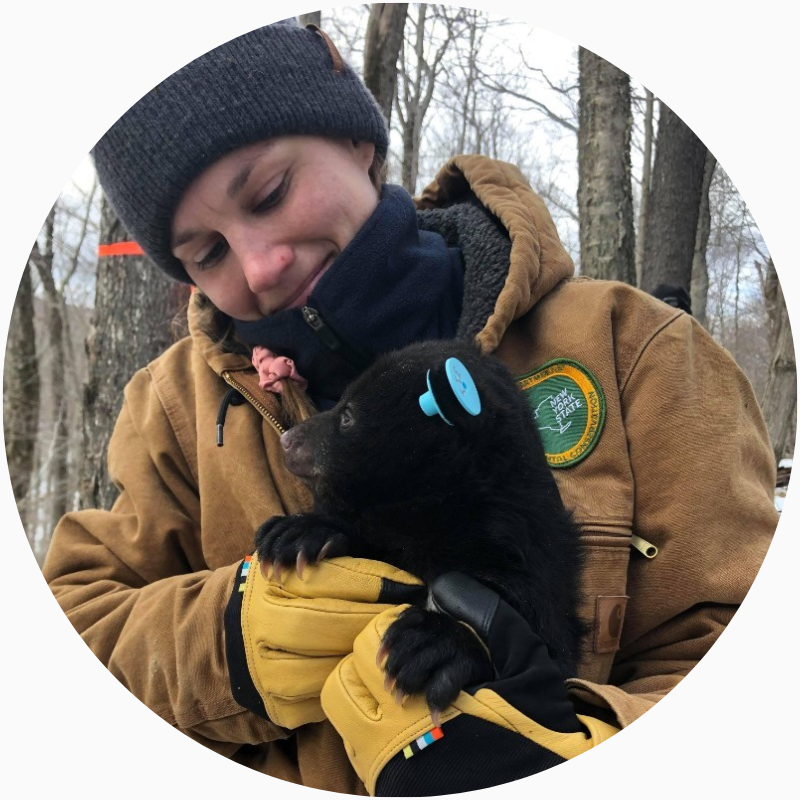
Emily Carrollo
Emily Carrollo is the Game Commission’s Black Bear Program Manager.